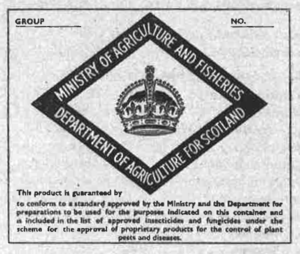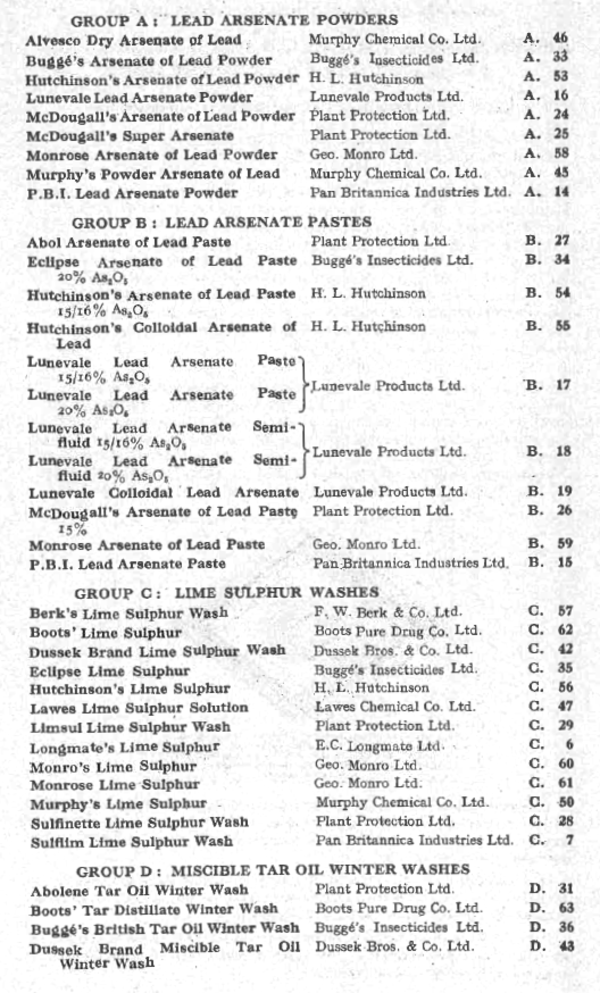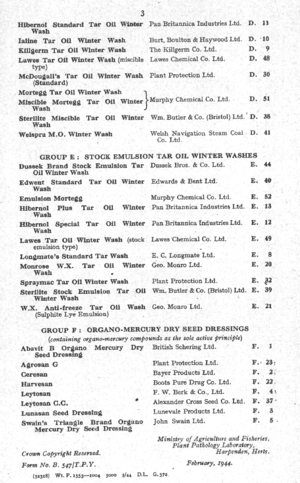In 1943 the then Ministry of Agriculture and Fisheries introduced an Approvals Scheme for proprietary insecticides and fungicides in certain chemical groups. This voluntary scheme was for efficacy only and the approved products had a logo on the label indicating that it did what was claimed.Manufacturers or their agents had to pay a non-returnable application fee of 3 guineas for each product. Another world!

The two scanned pages that appear later in this blog show the complete Approved Products list, first published in 1944. All pesticide groups were added over time. The voluntary Approval Scheme continued until 1985 and the annual list of Approved Products was published in what was known as the orange book. By the end of the scheme the orange book was the size of a longish novel. In 1985, the Food and Environmental Protection Act (FEPA) introduced comprehensive statutory controls of pesticides, including efficacy evaluation.
Amazingly, the efficacy based Approvals Scheme preceded any regulations relating to pesticide safety for human health and the environment. Eventually, The Agricultural (poisonous substances) Act 1952 was introduced to protect agricultural workers from the most toxic products by requiring that protective clothing be worn when using pesticides and restricting the hours permitted to work with them. In 1954 the Government established the Advisory Committee on Pesticides (ACP) as a principle source of advice on pesticide safety issues. A voluntary ‘Clearance’ scheme on pesticide safety, the Pesticides Safety Precautions Scheme (PSPS), ran from 1957 for agricultural products; non-agricultural products were included from the mid 1970s. This voluntary scheme was also subsumed into the first statutory controls under FEPA in 1985. It has to be stressed that whilst PSPS and the Approval Scheme were voluntary, every UK based manufacturer sold only ‘Cleared’ products whose uses were typically Approved a year or two after ‘clearance’. It was the advent of imported ‘Non-Cleared’ products that resulted in the introduction of statutory controls through FEPA.
It is interesting not only to look down the first list of approved products but also to look at the names of the companies selling them. Those as long in the tooth as I am will recognise many of the names but I think that Bayer and H.L Hutchinson are the only companies still trading. Bearing in mind that the year of the list is 1944, the inclusion of a German company is hard to understand. I assume that the then Bayer Products Ltd. was trading independently of its parent company! The other companies on the list have simply stopped trading or were subject to company mergers.
Looking down the list makes me grateful for the modern era of organic chemistry (also referred to as carbon-based or synthetic chemistry) which is the basis of not only more efficacious products but also safer products. Organic chemistry is perceived by some as unnatural but in the case of several products in the first approvals list, returning back to ‘natural products’ would have some serious consequences for human health and the environment.
Keep up to date with crop protection and crop production issues by attending the AAB/BCPC conference Crop Production in Southern Britain 2017, kindly supported by Adama. The conference is to be held on 15th and 16th February at the Peterborough Arena (on the showground). Click here for more details.


